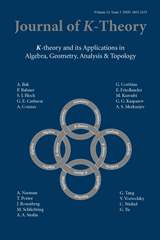Crossref Citations
This article has been cited by the following publications. This list is generated based on data provided by Crossref.
Banerjee, Abhishek
2016.
Realizations of pairs and Oka families in tensor triangulated categories.
European Journal of Mathematics,
Vol. 2,
Issue. 3,
p.
760.
Banerjee, Abhishek
2017.
On some spectral spaces associated to tensor triangulated categories.
Archiv der Mathematik,
Vol. 108,
Issue. 6,
p.
581.
Matsui, Hiroki
and
Takahashi, Ryo
2017.
Thick tensor ideals of right bounded derived categories.
Algebra & Number Theory,
Vol. 11,
Issue. 7,
p.
1677.
Heller, Jeremiah
and
Ormsby, Kyle
2018.
Primes and fields in stable motivic homotopy theory.
Geometry & Topology,
Vol. 22,
Issue. 4,
p.
2187.
Balmer, Paul
2018.
On the surjectivity of the map of spectra associated to a tensor‐triangulated functor.
Bulletin of the London Mathematical Society,
Vol. 50,
Issue. 3,
p.
487.
Banerjee, Abhishek
2018.
A topological nullstellensatz for tensor-triangulated categories.
Comptes Rendus. Mathématique,
Vol. 356,
Issue. 4,
p.
365.
Gallauer, Martin
2019.
tt-geometry of Tate motives over algebraically closed fields.
Compositio Mathematica,
Vol. 155,
Issue. 10,
p.
1888.
Kelly, Shane
2020.
Bousfield Classes and Ohkawa's Theorem.
Vol. 309,
Issue. ,
p.
221.
Gallauer, Martin
2021.
A note on Tannakian categories and mixed motives.
Bulletin of the London Mathematical Society,
Vol. 53,
Issue. 1,
p.
119.
Balmer, Paul
and
Gallauer, Martin
2022.
Three real Artin-Tate motives.
Advances in Mathematics,
Vol. 406,
Issue. ,
p.
108535.
TADA, Shunsuke
2023.
PRIME TENSOR IDEALS IN ABELIAN CATEGORIES OF REPRESENTATIONS OF QUIVERS OF TYPE <i>A </i>.
Kyushu Journal of Mathematics,
Vol. 77,
Issue. 1,
p.
159.
Balmer, Paul
and
Gallauer, Martin
2024.
The spectrum of Artin motives.
Transactions of the American Mathematical Society,
Vol. 378,
Issue. 3,
p.
1733.


